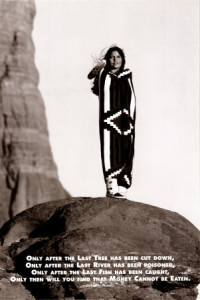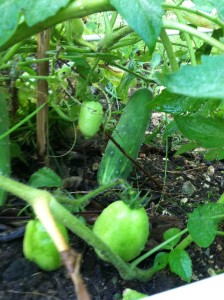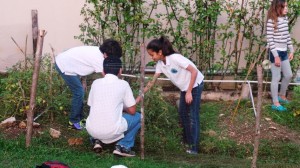The Green Experiment Part 3: School and Community Garden
This is the third installment by guest blogger Laura Tejeda, explaining how our school began its sustainable garden project three years ago. If you missed the first two posts, you can catch up here: The Green Experiment Intro and Composting. Another one of our teachers, Valerie Martinez, also writes about her experience with the garden project here.
A Cree Indian Proverb states: “Only when the last tree has died, and the last river been poisoned, and the last fish has been caught will we realize that we cannot eat money.” This proverb hit me like a ton of bricks: in today’s world, nearly everything we do revolves around our capacity to make and spend money. Sure, everyone wants it, and most people need it to make it in the modern world, but we cannot eat or breathe it, and it most definitely does not grow on trees.
(Editor’s note: wonder what life would be like if you gave up money? Check out Mark Doyle’s inspiring story)
 Growing up in the Dominican Republic, I had the opportunity to savor fresh fruit daily. In a country that has fertile soil and excellent vegetable-growing weather year-round, one would think basic gardening skills would be part of the core curricula – but they’re not. The only thing students learn about growing vegetables are a few facts about the country’s prime growing season and foreign exportation that they must memorize in order to pass the national standardized tests in the 8th and 12th grades.
Growing up in the Dominican Republic, I had the opportunity to savor fresh fruit daily. In a country that has fertile soil and excellent vegetable-growing weather year-round, one would think basic gardening skills would be part of the core curricula – but they’re not. The only thing students learn about growing vegetables are a few facts about the country’s prime growing season and foreign exportation that they must memorize in order to pass the national standardized tests in the 8th and 12th grades.
As part of my thesis pilot project we decided to attempt our TCFL version of a sustainable school and community garden. The initial idea was to connect this project to the Poverty Unit we already cover in 6th grade. Vegetables were to be sold by the students to the community around the school, making just enough profit to make the garden sustainable for the next school year (our growing season). Not only would the children learn everything required to grow their own food and promote healthier eating habits and sustainable farming practices, but it would make students think about how gardening could be used to break the poverty cycle in our small, developing country.
Once again, as I drafted the original lesson plans and developed the timelines, the pilot sounded beautiful on paper… but to my surprise, this beauty was not short-lived. Even though I was hundreds of miles away in the cold of upstate NY, pictures and Skype conversations with Gaby Flaquer, the 6th grade teachers, and the students showed me how they made it work! Not only did they manage to grow vegetables and sell them (all in the first year of implementation) but they also dealt with pests using organic fertilizers, and most of the materials used in the nursery were made out of recyclables (plastic bottles, glass jars, old desks, you name it). The best connection of all was completely unexpected and unplanned for: teachers and students shared their knowledge about gardening with Aldeas Infantiles (an NGO dedicated to fostering orphan children in a gated community) so that they too could grow their own vegetables!
When it came time to qualitatively and quantitatively assess the level of environmental knowledge gained  through the activity, we noticed that this is where the project had fallen short. But to my surprise and delight, teachers, students and staff were up to giving it another go the following school year. Students wanted to start growing their own vegetables at home and suggested that learning how to grow in small places like balconies and rooftops was something to include in the lesson plan for future years. Teachers said they loved the project, but the work load was huge, so requesting more help and training was a must.
through the activity, we noticed that this is where the project had fallen short. But to my surprise and delight, teachers, students and staff were up to giving it another go the following school year. Students wanted to start growing their own vegetables at home and suggested that learning how to grow in small places like balconies and rooftops was something to include in the lesson plan for future years. Teachers said they loved the project, but the work load was huge, so requesting more help and training was a must.
This year, the garden is blooming again and, I’m very sure, so is knowledge and critical thinking! Not to mention, the environment is getting its fair share of attention! Double win? You betcha!
Note:*****Visit our flickr page for more garden pictures.

Leave a comment